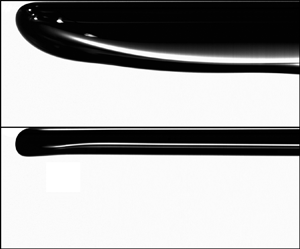Article contents
Dynamics of elongated bubbles in slightly inclined pipes with viscous fluids
Published online by Cambridge University Press: 21 December 2023
Abstract

In this work, the relationship between the velocity of an elongated bubble and its shape is investigated, in the case where the elongated bubble flows in a viscous liquid initially at rest in a pipe. The velocity, expressed as a Froude number, depends on the angle of the inclined pipe, the Eötvös number and the buoyancy Reynolds number. The diameter of the pipe and the surface tension being fixed, the Eötvös number remains constant; this study focuses on the dependence of the velocity on the pipe inclination angle and the viscosity of the liquid. The velocity of the elongated bubble was measured for different angles between 0 and 15 degrees and for liquid viscosities 10 to 200 times that of water. As the velocity of elongated bubbles depends closely on their shape, shadowgraphy coupled with particle image velocimetry was used. The results show that the velocity of the elongated bubbles is highly sensitive to the inclination angle of the pipe and to the viscosity of the liquid, particularly for low pipe inclinations and large viscosities. In the layer of liquid located downstream of the elongated bubble, laminar flow develops rapidly in the liquid, resulting from a balance between gravity and friction at the wall. The identification of the position of the stagnation point close to the nose of the elongated bubble and the curvature of the interface at this point helps to explain why the velocity of the elongated bubble decreases for low angles and high viscosities.
JFM classification
- Type
- JFM Papers
- Information
- Copyright
- © The Author(s), 2023. Published by Cambridge University Press
References
- 5
- Cited by



